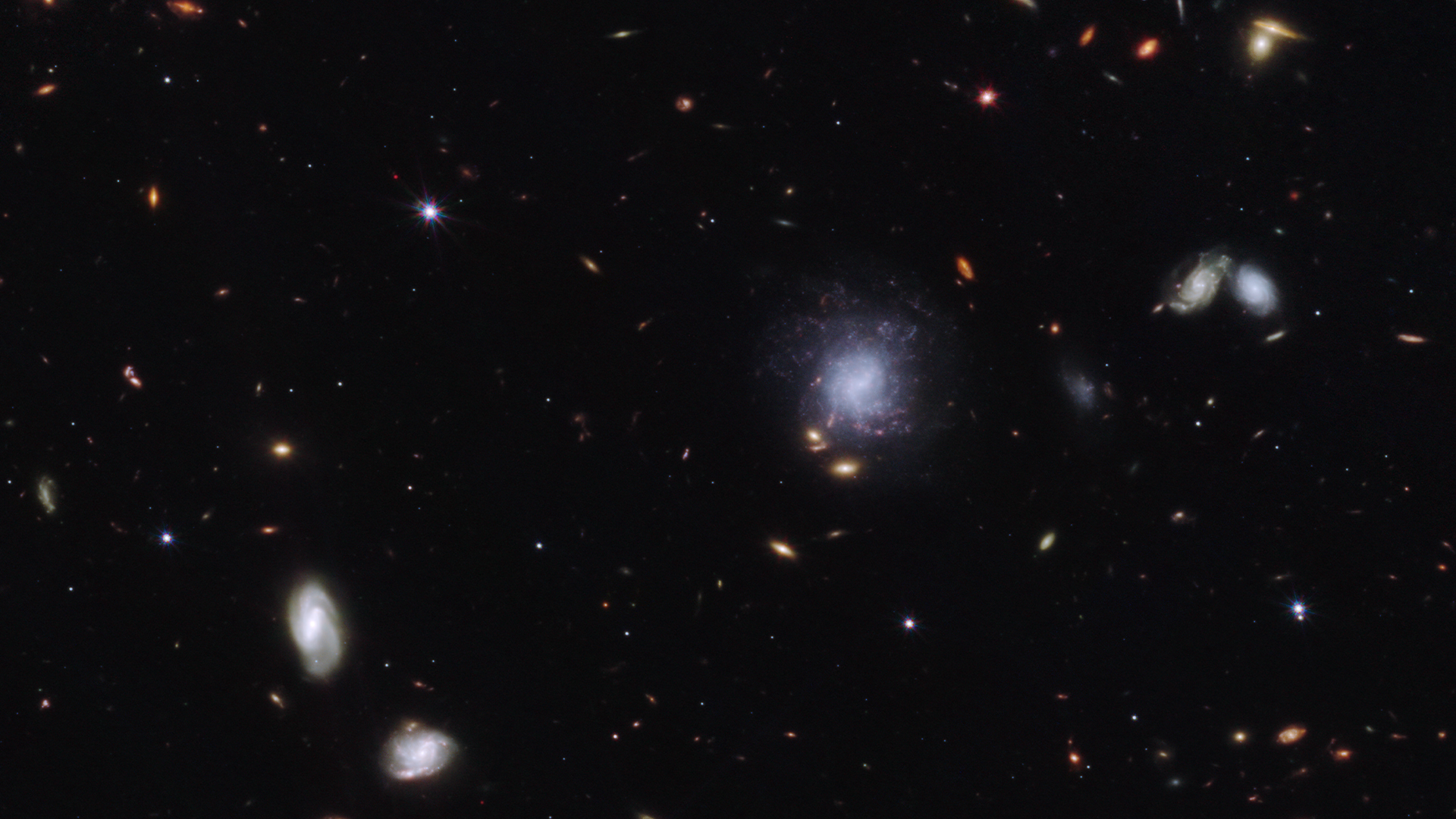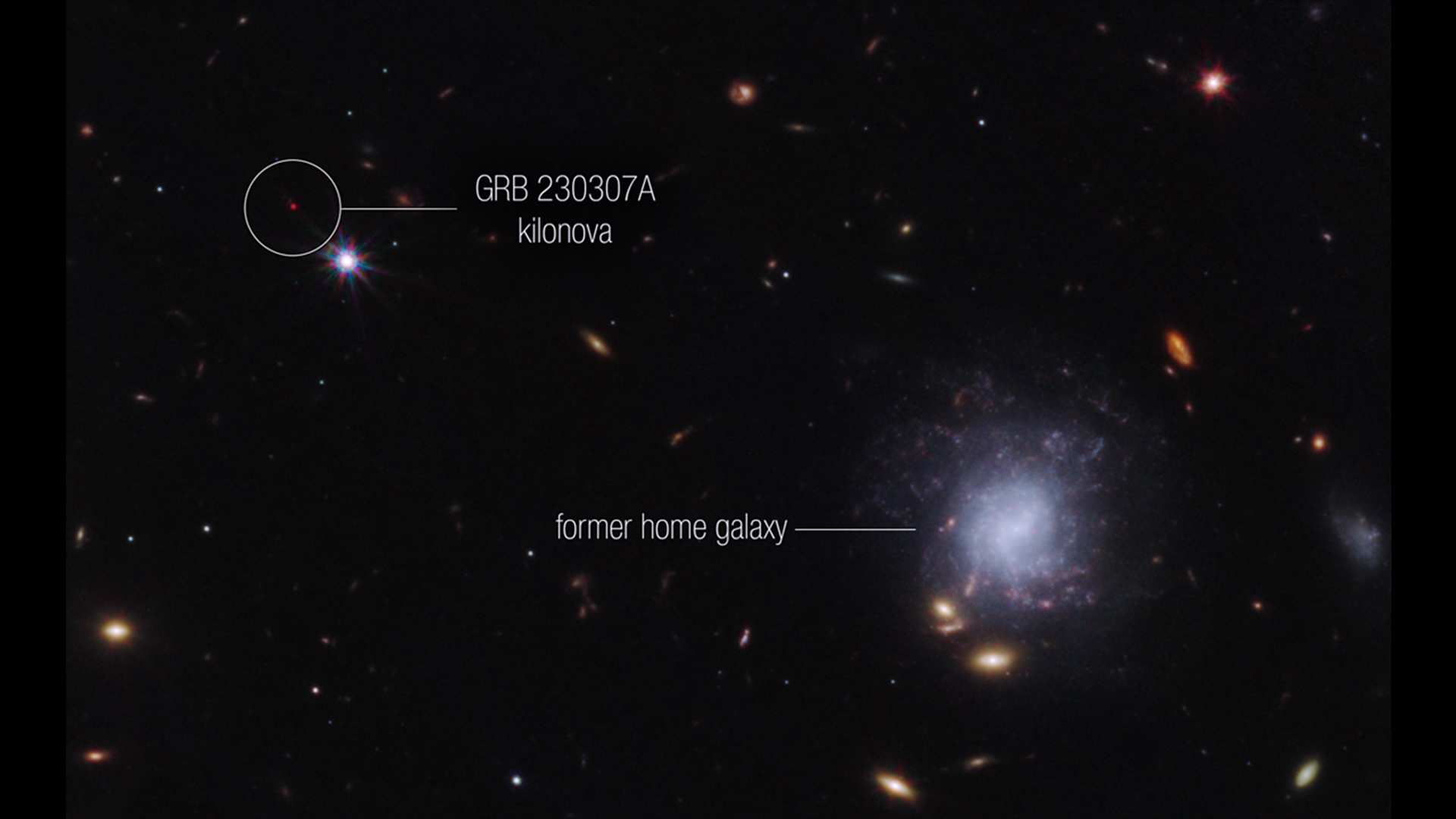James Webb telescope spots ultra-rare cosmic explosion that could reveal the origin of the universe’s heaviest elements
The James Webb Space Telescope's detection of tellurium in the violent environment of a dead-star merger is a step toward determining where the universe's heaviest elements come from.

Using an incredibly bright gamma-ray as a guide, the James Webb Space Telescope (JWST) has detected the heavy element tellurium around the site of a stellar-corpse collision. The discovery brings scientists a step closer to understanding where the universe's heaviest elements come from.
While scientists know that elements lighter than iron are forged in the hearts of massive stars, even the most massive stellar bodies aren't capable of generating hot and dense enough conditions at their cores to forge heavier elements such as gold, platinum or tellurium.
Neutron stars are created when stars can no longer perform nuclear fusion and collapse under their own gravity, creating matter so dense that a teaspoon of it would weigh 10 million tons (9 million metric tons). When neutron stars collide, this incredibly dense matter is sprayed into their immediate environment. This matter is rich in free neutrons, which can be captured by atoms, creating unstable atoms that eventually decay into elements with high numbers of protons and neutrons — the heavier elements in the periodic table. The decay of these elements also releases an explosion of electromagnetic radiation that astronomers see as a bright blast known as a kilonova.
"In the hunt for the heaviest elements, kilonovas are the main suspect," Darach Watson, an associate professor at the Niels Bohr Institute's Cosmic Dawn Center in Denmark, told Live Science.
However, the "smoking gun" evidence of this process has yet to be seen, partially because kilonovas are extremely rare. This discovery made with JWST brings researchers a tantalizing step closer to that evidence.
"In the one previous good set of data we have for a kilonova, we have discovered strontium and evidence for yttrium," Watson said. "But these are relatively light, with around 85 to 90 protons and neutrons."
Get the world’s most fascinating discoveries delivered straight to your inbox.
Watson, who co-authored a paper detailing the findings published Oct. 25 in the journal Nature, explained that tellurium, with 128 protons and neutrons, gets scientists much closer to really heavy elements and pinpointing neutron-star mergers as the sites of heavy-element production.
"We would like to find elements closer to the heaviest elements, such as uranium, which has about 235 protons and neutrons," Watson said. "There is a very long way from around 90 to around 240.
Kilonova hunting
To take this important step and to make its first detection of a single element around a neutron star merger, JWST used the gamma-ray burst GRB 230307A, which was first detected by the Fermi Gamma-ray Space Telescope in March 2023. The emission was around 1,000 times brighter than the gamma-ray bursts that Fermi usually spots, lasted 200 seconds and seemed to be coming from a neutron-star collision, which was unusual because these events usually create much shorter-duration gamma-ray bursts.
Using an array of ground- and space-based telescopes, scientists detected the rough source of GRB 230307A in the sky. Observing the source in gamma-ray, X-ray, optical, infrared, and radio wave frequencies of light showed that the source was characteristic of a kilonova explosion.
During the later period of the explosion, as the kilonova light moved into the infrared, it became unobservable from Earth but an excellent target for JWST's highly-sensitive infrared detectors.
In addition to spotting the telltale emissions of tellurium, JWST pinpointed a spiral galaxy 120,000 light-years from the kilonova where the dead stars likely originated. The team suspects the neutron stars involved in the merger that created the kilonova were ejected from this galaxy as a binary pair and traveled a distance equal to the width of the Milky Way together, before finally spiraling together and merging.
Watson believes the detection of this heavy element around the neutron star merger wouldn't have been possible without JWST, the most powerful telescope humanity has ever put into space.
"Nothing else even gets close to the JWST!" he said. "The sensitivity of JWST is just amazing, and at these wavelengths, it is completely unparalleled. I mean, we knew in principle what it could do, but I think everybody was unprepared for this."
Robert Lea is a science journalist in the U.K. who specializes in science, space, physics, astronomy, astrophysics, cosmology, quantum mechanics and technology. Rob's articles have been published in Physics World, New Scientist, Astronomy Magazine, All About Space and ZME Science. He also writes about science communication for Elsevier and the European Journal of Physics. Rob holds a bachelor of science degree in physics and astronomy from the U.K.’s Open University




